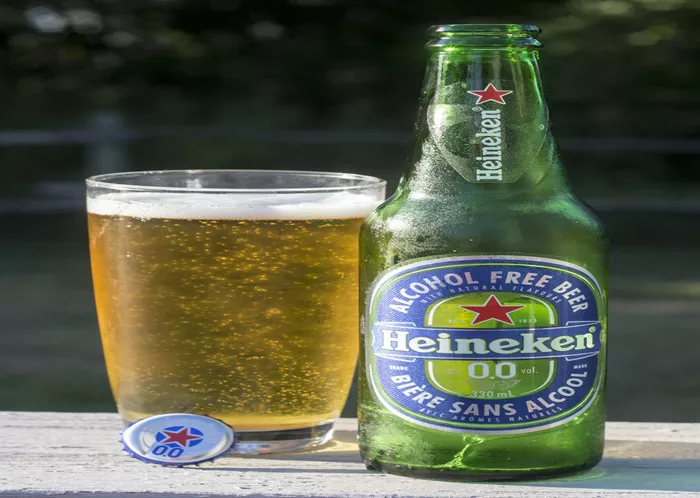Heineken is one of the most popular beer brands in the world, known for its crisp and refreshing taste. In recent years, Heineken has also released a non-alcoholic version of its beer, which has become increasingly popular among those who want to enjoy the taste of beer without the alcohol content. In this essay, we will explore how Heineken non-alcoholic beer is made, from the ingredients used to the brewing process.
Ingredients:
The first step in making Heineken non-alcoholic beer is to gather the necessary ingredients. The ingredients used in non-alcoholic beer are similar to those used in regular beer, with one key difference: the alcohol content is removed after the beer is brewed. The main ingredients in Heineken non-alcoholic beer include water, malted barley, hops, and yeast.
1. Water
Water is the primary component of Heineken beer, accounting for the majority of its volume, typically more than 90%.
Heineken uses high-quality water, often sourced from specific regions known for their pure water sources.
The water undergoes a meticulous filtration process to remove impurities and ensure it meets the strict standards required for brewing. This filtration helps to create a clean and refreshing base for the beer, contributing to its overall taste and quality.
2. Barley:
Barley is a crucial ingredient in Heineken beer. It provides the foundation for the beer’s flavor, body, and color.
The barley used by Heineken is sourced from select regions, such as Germany and Austria, which are renowned for producing high-quality barley.
Before being used in the brewing process, the barley is malted. This process involves germinating the barley and then drying it, which converts its starches into sugars. These sugars are then available for fermentation by the yeast.
During the brewing, the malted barley is crushed and mixed with hot water to create a sweet liquid called wort. The quality and type of barley used have a significant impact on the final flavor and character of the beer.
3. Hops:
Hops are added to the brewing process to impart flavor, aroma, and bitterness to the beer. They also have antibacterial properties that help preserve the beer.
Heineken sources its hops from various regions around the world, including European countries like Slovenia, the Czech Republic, and Germany, as well as from New Zealand and North America.
Different hop varieties are used to achieve the specific flavor profile of Heineken beer. The brewers carefully balance the amount of hops added to ensure the right level of bitterness and aroma, which complements the sweetness from the malted barley.
Hops are added to the wort during the boiling stage of the brewing process and play a vital role in defining the overall taste and character of the beer.
4. Yeast:
Yeast is the key ingredient that drives the fermentation process in Heineken beer.
Heineken uses a special A-yeast that has a long history and unique characteristics. It was first cultivated in a lab in 1886 by a student of Louis Pasteur and is still used exclusively by Heineken today.
When the yeast is added to the cooled wort in the fermentation tanks, it begins to convert the sugars from the malted barley into alcohol and carbon dioxide.
The fermentation process is carefully monitored and controlled to ensure that the yeast functions optimally, resulting in the desired alcohol content and flavor profile for the beer. The type of yeast used by Heineken contributes significantly to its distinct taste and fermentation characteristics.
See Also: Beer vs. Whiskey: Which Is Better?
Brewing Process:
Once the ingredients have been gathered, the next step is to brew the beer. The brewing process for non-alcoholic beer is similar to that of regular beer, with a few key differences.
1. Mashing:
The first step in the brewing process is mashing, in which the malted barley is mixed with hot water to create a sweet, sticky liquid called wort. The wort is then boiled with hops to add bitterness and flavor to the beer.
2. Fermentation:
After the wort has been boiled, it is cooled and yeast is added. In non-alcoholic beer, a special strain of yeast is used that does not produce alcohol. The yeast consumes the sugars in the wort and produces carbon dioxide and other flavor compounds.
3. Alcohol Removal:
Once the beer has fermented and developed its flavor, the alcohol content is removed. There are several methods for removing alcohol from beer, including vacuum distillation, reverse osmosis, and dialysis. Heineken uses a process called vacuum distillation, in which the beer is heated under reduced pressure to remove the alcohol.
4. Packaging:
After the alcohol has been removed, the beer is packaged in bottles or cans and shipped to stores and bars. Heineken non-alcoholic beer is packaged in the same green bottles as regular Heineken beer, with a blue label to indicate that it is non-alcoholic.
Conclusion:
In conclusion, Heineken non-alcoholic beer is made using similar ingredients and brewing methods as regular beer, with the key difference being the removal of alcohol after the beer is brewed. The ingredients used in non-alcoholic beer include water, malted barley, hops, and yeast, and the brewing process involves mashing, fermentation, and alcohol removal. Heineken uses vacuum distillation to remove the alcohol from its non-alcoholic beer, and the beer is packaged in the same green bottles as regular Heineken beer with a blue label.
You might be interested


